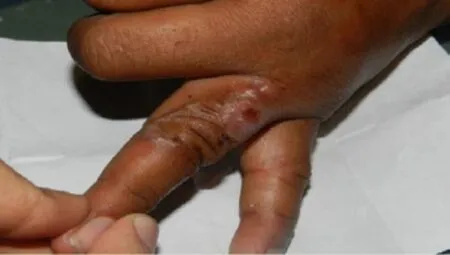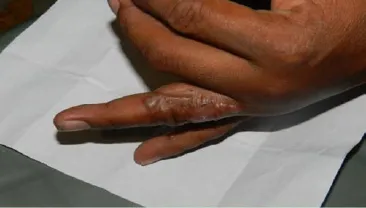A case report of cutaneous larva migrans in a Mexican population of high marginalization
Isaac Aguirre Maldonadoa, Silvia Cruz Duartea, Felipe González Velázqueza, Alfonso Alexander Aguilerab
1Escuela de Medicina, Universidad Cristóbal Colón. Carr. Veracruz-Medellin s/n, Col. Puente Moreno, Boca del Río, Ver. 94271. México.
2Facultad de Bioanálisis, Universidad Veracruzana. Carmén Serdan s/n, Col. Flores Magón, Veracruz, Ver. 91700. México.
A case report of cutaneous larva migrans in a Mexican population of high marginalization
Isaac Aguirre Maldonadoa1, Silvia Cruz Duartea1, Felipe González Velázqueza1, Alfonso Alexander Aguilerab2*
1Escuela de Medicina, Universidad Cristóbal Colón. Carr. Veracruz-Medellin s/n, Col. Puente Moreno, Boca del Río, Ver. 94271. México.
2Facultad de Bioanálisis, Universidad Veracruzana. Carmén Serdan s/n, Col. Flores Magón, Veracruz, Ver. 91700. México.
ARTICLE INFO
Article history:
Received 7 Mar 2014
Received in revised form 19 Apr 2014
Accepted 25 May 2014
Available online 8 Jul 2014
Larva migrans
Pruritic
Purple vesicle
Serpiginous
Dermatology lesion
The creeping verminous dermatitis or cutaneous larva migrans is a parasitosis caused by percutaneous penetration and migration of larval nematode parasites characterized by producing one or more serpiginous erythematous, indurated, raised and pruritic lesion. The most common cause of cutaneous larva migrans is the Ancylostoma braziliense located in warm climate zones. In the present study, authors reported a case of cutaneous larva migrans with a characteristic clinical picture: erythematous-papular and vesicular lesion and serpiginous path, with progressive, and pruritic growth and it shown that a living area with immigration, tropical weather conditions and poverty may lead to this common infection.
1. Introduction
Cutaneous larva migrans (CLM) is a creeping eruption of the skin, which is caused by an accidental infection and migration of nematode larvae. Usually the hookworm comes from dogs, cats and other mammals, through the epidermis[1].Ancylostoma brazilienseis the most common cause of CLM[1]. Other skin penetrating nematode larvae includeAncylostoma caninum,Uncinaria stenocephala,Bunostomum phlebotomum, andStrongyloides stercoralis[1-3]. Sometimes otherparasites includeGnathostoma spinigerum,Strongyloides procyonis,Dirofilaria repens, and some forms of myiasis can cause migratory skin lesions[4]. CLM is the most common tropically dermatosis[5]. The first report is done by Lee in 1874[6]. Because of biogeographical conditions, this disease often affects travelers returning from warm climate countries[7]. The disease is endemic in resourcepoor communities in the developing world, particularly in Brazil, India, and the West Indies. It occurs sporadically or in the form of small epidemics in high-income countries and is reported in tourists who have visited the tropics[8]. This case was found in a Mexican population of high marginalization in the state of Veracruz.
2. Case report
A 39-year-old male with job of masonrywall wasadmitted in our medical office of the Cristobal Colon University, for present pruritic, painful cutaneous lesions, which had been progressing for 1 week. The physical examination revealed a serpiginous lesion in skin, with vesicles in the lateral region of the left annular finger (Figures 1 and 2). This patient was found to present with signs and symptoms of diabetes mellitus. There was no eosinophilia in the blood count, the glucose was increased and there was glucosuria and proteinuria in the urinalysis. The patient was treated with oral albendazole (400 mg per day for 7 d) and dicloxacillin (500 mg every 8 h for 8 d) for secondary infection signs.

Figure 1. Photograph of lateral aspect of the left annular finger showing serpiginous lesion in skin.

Figure 2. Photograph of lateral aspect of the left annular finger showing purpuric vesicles.
3. Discussion
CLM is a frequent disease in tropical and subtropical countries. The endemic nature of this disease is caused by poor sanitation and environmental conditions[5]. Accidentally, the cutaneous larva migrans can enter the epidermis but cannot penetrate the dermis, so they migrate within the epidermis for a few weeks before dying[5]. The clinical appearance of this infestation is a serpiginous cutaneous eruption usually occurring on the skin of the feet, abdomen, buttocks, hands, and genitals[9]. Eruption is a result of the skin’s hypersensitivity reaction to these worms and their by-products[9].
The diagnosis of CLM is based on physical examination in conjunction with the epidemiologic background[5,10]. Our patient lives in a highly marginal zone of Veracruz with very frequent tourist activities and a significant number of immigrants from South America. This living environment, in addition to the patient’s work in masonry, generats greater contact with contaminated soil withA. braziliense.
Although laboratory studies show that the patient has diabetes mellitus type 2 and diabetic nephropathy, in the blood count, eosinophil values were normal, ruling L?ffler’s syndrome.
Conflict of interest statement
We declare that we have no conflict of interest.
[1] Davies HD, Sakuls P, Keystone JS. Creeping eruption. A review of clinical presentation and management of 60 cases presenting to a tropical disease unit. Arch Dermatol 1993; 129: 588-591.
[2] Lucchina LC, Wilson ME. Cysticercosis and other helminthic infections. In: Freedberg IM, Eisen AZ, Wolff K, editors. Fitzpatrick’s dermatology in general medicine. 5th ed. New York, USA: McGraw-Hill; 1999, p. 87-100.
[3] Alonso FF. Cutaneous larva migrans. In: Harper J, Oranje A, Neil P, editors. Textbook of pediatric dermatology. Hoboken, USA: Wiley-Blackwell; 2000, p. 527-530.
[4] Kwon IH, Kim HS, Lee JH, Choi MH, Chai JY, Nakamura-Uchiyama F, et al. A serologically diagnosed human case of cutaneous larva migrans caused by Ancylostoma caninum. Korean J Parasitol 2003; 41: 233-237.
[5] Miljkovi? J, Breznik V. Cutaneous larva migrans in two Slovenian travelers returning from Brazil. Acta Dermatovenerol Alp Panonica Adriat 2008; 17(2): 83-85.
[6] Lee RJ. Case of creeping eruption. Trans Clin Soc London 1874; 8: 44-45.
[7] Brenner MA, Patel MB. Cutaneous larva migrans: the creeping eruption. Cutis 2003; 72: 111-115.
[8] Heukelbach J, Feldmeier H. Epidemiological and clinical characteristics of hookworm-related cutaneous larva migrans. Lancet Infect Dis 2008; 8: 302-309.
[9] Ghosh SK, Bandyopadhyay D. Dermacase: can you identify this condition? Cutaneous larva migrans. Can Fam Physician 2009; 55(5): 489-491.
[10] Jelinek T, Maiwald H, Nothdurft HD, L?scher T. Cutaneous larva migrans in travelers: synopsis of histories, symptoms, and treatment of 98 patients. Clin Infect Dis 1994; 19(6): 1062-1066.
10.12980/APJTB.4.2014APJTB-2014-0119
*Corresponding author: Alfonso Alexander Aguilera, Facultad de Bioanálisis, Universidad Veracruzana. Carmén Serdan s/n, Col. Flores Magón, Veracruz, Ver. 91700. México.
Fax: (229) 9-32-17-07.
E-mail: aalexander@uv.mx, aalexander_2000@yahoo.com
 Asian Pacific Journal of Tropical Biomedicine2014年9期
Asian Pacific Journal of Tropical Biomedicine2014年9期
- Asian Pacific Journal of Tropical Biomedicine的其它文章
- Acute brucellosis as unusual cause of immune thrombocytopenia: a case report and review of the literature
- Chemical composition and larvicidal activity of essential oil of Origanum majorana (Lamiaceae) cultivated in Morocco against Culex pipiens (Diptera: Culicidae)
- Hematological and serum biochemical aspects associated with a camel (Camelus dromedarius) naturally infected by Trypanosoma evansi with severe parasitemia in Semnan, Iran
- Phytochemical screening and antioxidant activity of ethanol extract of Tithonia diversifolia (Hemsl) A. Gray dry flowers
- Rate of carcass and offal condemnation in animals slaughtered at Yazd Slaughterhouse, central Iran
- Formulation and evaluation of novel stomach specific floating microspheres bearing famotidine for treatment of gastric ulcer and their radiographic study
